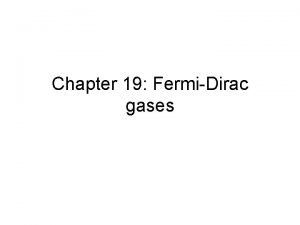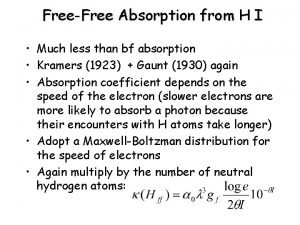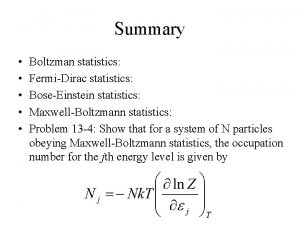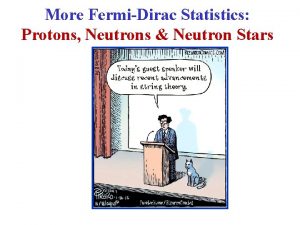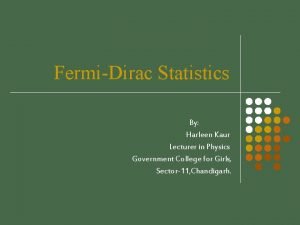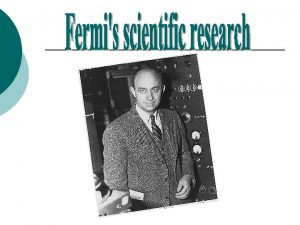More FermiDirac Statistics 1 More FermiDirac Statistics Free















- Slides: 15

More Fermi-Dirac Statistics 1

More Fermi-Dirac Statistics Free Electron Model of Conduction Electrons in Metals • Let g(E) Density of States at energy E. g(E) = number of states between E & E +d. E • For free electrons, E = (ħ 2 k 2)/(2 m) • For free electrons, it can be shown that 2

• As already discussed, the Fermi Function f(E) gives the number of the existing states at energy E that will be filled with electrons at temperature T. • The function f(E) specifies, under equilibrium conditions, the probability that an available state at energy E will be occupied by an electron. It is: EF = Fermi energy or Fermi level k = Boltzmann constant = 1. 38 10 23 J/K = 8. 6 10 5 e. V/K T = absolute temperature in K 3

Fermi-Dirac Distribution Consider T 0 K For E > EF : For E < EF : E A step function! EF 0 1 f(E)

Fermi Function at T= 0 & at Finite Temperature At T = 0 K a. E < EF f. FD(E, T) b. E > EF E E<EF EF E>EF 5

• What is the number of electrons per unit energy range according to the free electron model? • This shows the change in distribution between absolute zero and a finite temperature. • n(E, T) = number of free electrons per unit energy range = area under n(E, T) graph.

• The FD distribution function is a symmetric function; at finite temperatures, the same number of levels below EF are emptied and same number of levels above EF are filled by electrons.

Equilibrium Distribution of Electrons at energy E = Density of States Probability of Occupancy = g(E)f(E) • The total number of conduction electrons at energy E & temperature T is N E 0 g(E) f(E)d. E 8

Total Energy of a Gas of N Electrons Note: E Sorry!

• At T = 0, U = (3/5)NεF , this energy is large because all the electrons must occupy the lowest energy states up to the Fermi level. < > for a free electron in silver at T = 0: • The mean kinetic energy of an electron, even at T = 0, is 2 orders of magnitude greater than the mean kinetic energy of an ordinary gas molecule at room temperature.

Heat Capacity at Low T • The Total Energy at Temperature T: • The electronic heat capacity Ce can be found by taking the temperature derivative of U: • For temperatures T small compared with TF (true for any metal at room temperature), neglect the 2 nd term in the expansion & get

• For silver at room temperature: • So, the electronic specific heat = 2. 2 x 10 -2 R. This small value explains why metals have a specific heat capacity of about 3 R, the same as for other solids. • It was originally believed that their free electrons should contribute an additional (3/2) R associated with their three translational degrees of freedom. The calculation shows that this contribution is negligible. • The energy of the electrons changes only slightly with temperature (d. U/d. T is small) because only those electrons near the Fermi level can increase their energies as the temperature is raised, & there are very few of them.

• S = 0 at T = 0, as it must be. • The Helmholtz function F = U -TS is • The Fermion equation of state is:

• Silver: N/V = 5. 9 1028 m-3 so TF = 65, 000 K. • So, P = (2/5) (5. 9 1028)(1. 38 10 -23) (6. 5 104) = 2. 1 1010 Pa = 2. 1 105 atm = Pressure inside the electron gas! • Given this tremendous pressure, it is clear that the surface potential barrier needs to be huge in order to keep the electrons from evaporating from the metal.

Fermi energy for Aluminum assuming three electrons per Aluminum atom:
 More more more i want more more more more we praise you
More more more i want more more more more we praise you More more more i want more more more more we praise you
More more more i want more more more more we praise you Fermidirac
Fermidirac Introduction to statistics what is statistics
Introduction to statistics what is statistics Helmholtz free energy and gibbs free energy
Helmholtz free energy and gibbs free energy Negative free energy change
Negative free energy change Free hearts free foreheads you and i are
Free hearts free foreheads you and i are Gibbs free energy non standard conditions
Gibbs free energy non standard conditions The story of an hour summary
The story of an hour summary Allocation map
Allocation map Free free absorption
Free free absorption Gibbs free energy spontaneous
Gibbs free energy spontaneous The more you take the more you leave behind
The more you take the more you leave behind More love to thee o lord
More love to thee o lord The more you study the more you learn
The more you study the more you learn More choices more chances
More choices more chances


